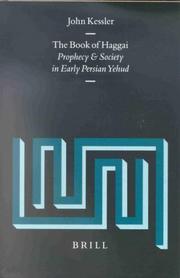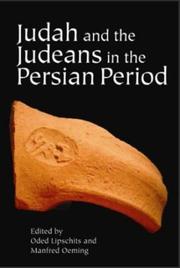| Listing 1 - 10 of 10 |
Sort by
|

ISBN: 9004124810 9004276173 9789004124813 9789004276178 Year: 2002 Volume: 91 Publisher: Leiden : E.J. Brill,
Abstract | Keywords | Export | Availability | Bookmark
 Loading...
Loading...Choose an application
- Reference Manager
- EndNote
- RefWorks (Direct export to RefWorks)
This monograph is a study of the perceptions reflected in the Book of Haggai regarding the primary social, political and religious institutions in early Persian Yehud. Special attention is given to the form and function of prophecy, and to the role of the prophet in society. The study includes a history of the criticism of Haggai, a study of the book’s redactional history and socio-political context, and an exegesis and literary analysis of the text. It concludes with an examination of the distinctive perspectives found in the book and the sociological and religious milieu that produced them. The work is particularly useful for its detailed analysis of the biblical text, its attention to recent literature on the early Persian period, and its multidisciplinary and integrative approach.
224.97 --- Aggeüs --- Yehud (Persian province) --- 224.97 Aggeüs --- Bible. --- Aga (Book of the Old Testament) --- Aggeus (Book of the Old Testament) --- Haggai (Book of the Old Testament)
Book
ISBN: 9781481313766 1481313762 9781481314190 9781481313759 Year: 2021 Publisher: Waco Baylor University Press
Abstract | Keywords | Export | Availability | Bookmark
 Loading...
Loading...Choose an application
- Reference Manager
- EndNote
- RefWorks (Direct export to RefWorks)
"A thematic survey of the various scenarios in the OT wherein silence, both divine and human, play a significant role, and an exploration of the latent theological meaning behind these varied situations"--
Silence in the Bible --- Silence --- Religious aspects --- Bible. --- Criticism, interpretation, etc.
Book
ISBN: 9781602587373 Year: 2013 Publisher: Waco Baylor University Press
Abstract | Keywords | Export | Availability | Bookmark
 Loading...
Loading...Choose an application
- Reference Manager
- EndNote
- RefWorks (Direct export to RefWorks)
Article
Abstract | Keywords | Export | Availability | Bookmark
 Loading...
Loading...Choose an application
- Reference Manager
- EndNote
- RefWorks (Direct export to RefWorks)
Book
Publisher: St Louis The rationalist association
Abstract | Keywords | Export | Availability | Bookmark
 Loading...
Loading...Choose an application
- Reference Manager
- EndNote
- RefWorks (Direct export to RefWorks)
Book

ISBN: 1575066114 9781575066110 9781575061658 1575061651 Year: 2021 Publisher: University Park, PA
Abstract | Keywords | Export | Availability | Bookmark
 Loading...
Loading...Choose an application
- Reference Manager
- EndNote
- RefWorks (Direct export to RefWorks)
Most of the essays in this volume stem from the special sessions of the Historiography Seminar of the Canadian Society for Biblical Studies, held in the late spring of 2007 (University of Saskatchewan). The papers in these focused sessions dealt with issues of self-identification, community identity, and ethnicity in Judahite and Yehudite historiography. The scholars present addressed a range of issues, such as the understanding, presentation, and delimitation of “Israel” in various biblical texts, the relationship of Israelites to Judahites in Judean historical writings, the definition of Israel over against other peoples, and the possible reasons why the ethnoreligious community (“Israel”) was the focus of Judahite/Yehudite historiography. Papers approached these matters from a variety of theoretical and disciplinary vantage points. For example, some pursued an inner-biblical perspective (pentateuchal sources/writings, Former Prophets, Latter Prophets, Chronicles, Ezra, Nehemiah), while others pursued a cross-cultural comparative perspective (ancient Near Eastern, ancient Greek and Hellenistic historiographies, Western and non-Western historiographic traditions). Still others attempted to relate the material remains to the question of community identity in northern Israel, monarchic Judah, and postmonarchic Yehud.
Ethnicity in the Bible --- Jews --- Hebrews --- Israelites --- Jewish people --- Jewry --- Judaic people --- Judaists --- Ethnology --- Religious adherents --- Semites --- Judaism --- History --- Historiography --- Identity --- Bible. --- Antico Testamento --- Hebrew Bible --- Hebrew Scriptures --- Kitve-ḳodesh --- Miḳra --- Old Testament --- Palaia Diathēkē --- Pentateuch, Prophets, and Hagiographa --- Sean-Tiomna --- Stary Testament --- Tanakh --- Tawrāt --- Torah, Neviʼim, Ketuvim --- Torah, Neviʼim u-Khetuvim --- Velho Testamento --- Criticism, interpretation, etc. --- 930.21 <33> --- 933.3 --- 933.3 Geschiedenis van het Joodse volk: Tweede Tempelperiode--(538 v.Chr.-70 n.Chr.) --- Geschiedenis van het Joodse volk: Tweede Tempelperiode--(538 v.Chr.-70 n.Chr.) --- 930.21 <33> Historiografie. Geschiedenis van de geschiedwetenschap--Oud-Palestina. Judea --- Historiografie. Geschiedenis van de geschiedwetenschap--Oud-Palestina. Judea --- Historiography. --- Ethnicity in the Bible. --- Historical criticism --- Authorship --- Identity, Jewish --- Jewish identity --- Jewishness --- Jewish law --- Jewish nationalism --- Identity. --- Criticism --- Ethnic identity --- Race identity --- Legal status, laws, etc. --- Palaia Diathēk
Book

ISBN: 9783110221787 Year: 2010 Publisher: Berlin Boston
Abstract | Keywords | Export | Availability | Bookmark
 Loading...
Loading...Choose an application
- Reference Manager
- EndNote
- RefWorks (Direct export to RefWorks)
Book

ISBN: 1575063573 9781575063577 1575063565 9781575063560 9781575063560 Year: 2021 Publisher: University Park, PA
Abstract | Keywords | Export | Availability | Bookmark
 Loading...
Loading...Choose an application
- Reference Manager
- EndNote
- RefWorks (Direct export to RefWorks)
The 22 essays in this new and comprehensive study explore how notions of covenant, especially the Sinaitic covenant, flourished during the Neo-Babylonian, Persian, and early Hellenistic periods. Following the upheaval of the Davidic monarchy, the temple’s destruction, the disenfranchisement of the Jerusalem priesthood, the deportation of Judeans to other lands, the struggles of Judeans who remained in the land, and the limited returns of some Judean groups from exile, the covenant motif proved to be an increasingly influential symbol in Judean intellectual life. The contributors to this volume, drawn from many different countries including Canada, Germany, Israel, South Africa, Switzerland, and the United States, document how Judean writers working within historiographic, Levitical, prophetic, priestly, and sapiential circles creatively reworked older notions of covenant to invent a new way of understanding this idea. These writers examine how new conceptions of the covenant made between YHWH and Israel at Mt. Sinai play a significant role in the process of early Jewish identity formation. Others focus on how transformations in the Abrahamic, Davidic, and Priestly covenants responded to cultural changes within Judean society, both in the homeland and in the diaspora. Cumulatively, the studies of biblical writings, from Genesis to Chronicles, demonstrate how Jewish literature in this period developed a striking diversity of ideas related to covenantal themes.
Covenant theology --- Jews --- Hebrews --- Israelites --- Jewish people --- Jewry --- Judaic people --- Judaists --- Ethnology --- Religious adherents --- Semites --- Judaism --- Biblical teaching. --- History --- 933.23 --- 933.3 --- 222 --- 222.1 --- 222.2 --- 224 --- 223.7 --- 222.7 --- 933.3 Geschiedenis van het Joodse volk: Tweede Tempelperiode--(538 v.Chr.-70 n.Chr.) --- Geschiedenis van het Joodse volk: Tweede Tempelperiode--(538 v.Chr.-70 n.Chr.) --- 933.23 Geschiedenis van het Joodse volk: ballingschap--(587-538 v.Chr.) --- Geschiedenis van het Joodse volk: ballingschap--(587-538 v.Chr.) --- Biblical teaching --- History&delete& --- Historische boeken van het Oude Testament --- Octateuch. Heptateuch. Hexateuch. Pentateuch. Boeken van Mozes --- Genesis --- Profetische boeken van het Oude Testament --- Wijsheid. Wijsheid van Jesus Sirach (Ecclesiasticus) --- Kronieken. Ezra. Nehemia --- Jews in Babylonian captivity (598 - 515 B.C.) --- Babylonisches Exil --- Bund Gottes --- Jews. --- Jewish question --- Bund --- Theologie des Bundes --- Gottesbund --- Bundestheologie --- Heilsgeschichte --- Föderaltheologie --- Babylonische Gefangenschaft --- Exil --- Juden --- Israel --- Babylonien --- v597-v538 --- Föderaltheologie


ISBN: 1575065614 9781575065618 157506104X 9781575061047 9781575061047 Year: 2021 Publisher: University Park, PA
Abstract | Keywords | Export | Availability | Bookmark
 Loading...
Loading...Choose an application
- Reference Manager
- EndNote
- RefWorks (Direct export to RefWorks)
In July 2003, a conference was held at the University of Heidelberg (Germany), focusing on the people and land of Judah during the 5th and early 4th centuries B.C.E.— the period when the Persian Empire held sway over the entire ancient Near East. This volume publishes the papers of the participants in the working group that attended the Heidelberg conference.Participants whose contributions appear here include: Y. Amit, B. Becking, J. Berquist, J. Blenkinsopp, M. Dandamayev, D. Edelman, T. Eskenazi, A. Fantalkin and O. Tal, L. Fried, L. Grabbe, S. Japhet, J. Kessler, E. A. Knauf, G. Knoppers, R. Kratz, A. Lemaire, O. Lipschits, H. Liss, M. Oeming, L. Pearce, F. Polak, B. Porten and A. Yardeni, E. Stern, D. Ussishkin, D. Vanderhooft, and J. Wright.The conference was the second of three meetings; the first, held at Tel Aviv in May 2001, was published as Judah and the Judeans in the Neo-Babylonian Period by Eisenbrauns in 2003. A third conference focusing on Judah and the Judeans in the Hellenistic era was held in the summer of 2005, at Münster, Germany, and will also be published by Eisenbrauns.
Jews --- Judaism --- Hebrews --- Israelites --- Jewish people --- Jewry --- Judaic people --- Judaists --- Ethnology --- Religious adherents --- Semites --- History --- Bible. --- Antico Testamento --- Hebrew Bible --- Hebrew Scriptures --- Kitve-ḳodesh --- Miḳra --- Old Testament --- Palaia Diathēkē --- Pentateuch, Prophets, and Hagiographa --- Sean-Tiomna --- Stary Testament --- Tanakh --- Tawrāt --- Torah, Neviʼim, Ketuvim --- Torah, Neviʼim u-Khetuvim --- Velho Testamento --- Criticism, interpretation, etc. --- Judaea (Region) --- Yehud (Persian province) --- Erets Yehudah (Region) --- Ereẓ Yehudah (Region) --- Judah, Land of (Region) --- Judea (Region) --- Land of Judah (Region) --- Yahūdhā (Region) --- Yehuda (Region)
Book

ISBN: 9781463241612 Year: 2019 Publisher: Piscataway, NJ
Abstract | Keywords | Export | Availability | Bookmark
 Loading...
Loading...Choose an application
- Reference Manager
- EndNote
- RefWorks (Direct export to RefWorks)
| Listing 1 - 10 of 10 |
Sort by
|

 Search
Search Feedback
Feedback About UniCat
About UniCat  Help
Help News
News